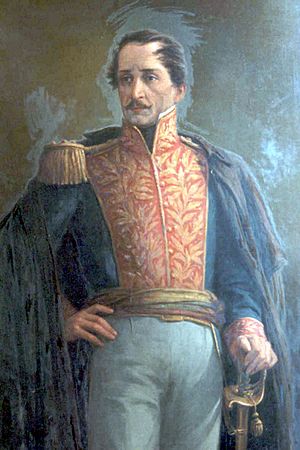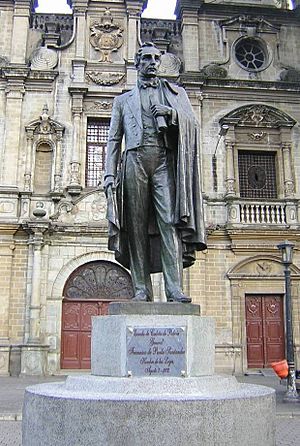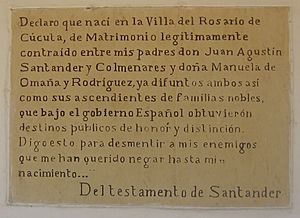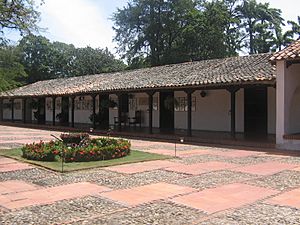Francisco de Paula Santander facts for kids
Francisco José de Paula Santander y Omaña (born April 2, 1792, died May 6, 1840) was an important military and political leader from Colombia. He played a key role during the independence war of the United Provinces of New Granada (which is now Colombia) from 1810 to 1819. Santander served as the acting President of Gran Colombia between 1819 and 1826. Later, he was elected by Congress as the President of the Republic of New Granada from 1832 to 1837. People often called him "The Man of the Laws" because he strongly believed in following rules and laws.
Quick facts for kids
Francisco de Paula Santander
|
|
|---|---|

Oil painting by Ricardo Acevedo Bernal.
|
|
| 1st President of the Republic of the New Granada | |
| In office October 7, 1832 – April 1, 1837 |
|
| Vice President | José Ignacio de Márquez |
| Preceded by | Office Created |
| Succeeded by | José Ignacio de Márquez |
| Vice President of the Republic of Colombia | |
| In office November 3, 1821 – September 19, 1827 |
|
| President | Simón Bolívar |
| Preceded by | Francisco Antonio Zea |
| Succeeded by | Juan German Roscio |
| Personal details | |
| Born |
Francisco José de Paula Santander y Omaña
2 April 1792 Villa del Rosario, Tunja Province, Viceroyalty of New Granada (present-day Norte de Santander, Colombia) |
| Died | 6 March 1840 (aged 47) Santa Fe de Bogotá, Cundinamarca, Republic of New Granada (present-day Colombia) |
| Nationality | Neogranadine |
| Political party | Federalist |
| Spouse | Sixta Tulia Pontón y Piedrahita |
| Children | Francisco de Paula Jesús Bartolomé, Clementina Santander y Pontón, Sixta Tulia Santander y Pontón |
| Alma mater | Colegio Mayor de San Bartolomé Universidad santo Tomás |
Contents
Early Life and Education
Santander was born in Villa del Rosario, near Cúcuta, on April 2, 1792. His parents were Juan Agustín Santander Colmenares and Manuela Antonia de Omaña Rodríguez. Both families were descendants of Spanish nobles who had settled in the New Kingdom of Granada. He died in Bogotá on March 6, 1840.
Military Beginnings
Santander was a law student when he began his military career at age eighteen. This was in 1810, when groups called juntas started the independence movement in New Granada. Santander joined the revolutionary army in October 1810. He first served as a soldier in the army of the federalist United Provinces of New Granada. This army fought against General Antonio Nariño, who led the Province of Cundinamarca.
During these early campaigns, Santander became a colonel in 1812. When Spanish forces took back New Granada, Santander and other officers went to the eastern plains, called the Llanos. There, Santander joined forces with Venezuelan patriots and worked under Simón Bolívar. During a military campaign across the Andes mountains, Bolívar promoted Santander to Brigadier General in 1817.
Key Battles and Promotions
By 1819, Bolívar gave Santander command of the republican army's front lines. This was during the important campaign to free New Granada. Santander was a key commander in the republican victory at the Battle of Vargas Swamp and later at the Battle of Boyacá on August 7, 1819. After these victories, he was promoted to Commanding General, which is like a major general today.
Santander as Vice President
In October 1821, after the Constitution of Cúcuta was announced, Santander was elected Vice President of Gran Colombia. He won a close election against General Antonio Nariño. Santander was put in charge of the government in New Granada. This was because General Simón Bolívar, who was the President, continued to lead the republican forces in campaigns in Ecuador and Peru.
The Constitution said that the Vice President had to stay in Bogotá. They would handle the daily tasks of the government. As acting ruler, Santander faced big challenges. The country had a serious economic crisis after years of war. There were also groups who still supported the Spanish king. Santander had to make sure the army had supplies for ongoing battles. He also worked to restart the government and make new laws.
First Term as Acting President
During his first time as acting President, Santander became a strong supporter of a centralized government. He believed in the Constitution of Cúcuta and worked to make it stronger. He also started to support free trade. He removed or lowered many taxes left over from Spanish rule. He opened ports for trade with all foreign nations. He also encouraged immigrants to come to the country. He made it easier for them to become citizens and offered them land.
When Bolívar returned in 1826, he took back his role as president. Bolívar often changed many of Santander's actions using emergency powers. Santander was very strict in dealing with those who opposed the new republic.
Political Differences with Bolívar

At first, Santander and Bolívar were close friends and allies. But over time, they started to have different political ideas. Santander believed strongly in following the Constitution and the rule of law. Bolívar, however, sometimes felt that these rules could be bent if the situation demanded it.
In 1826, when a rebellion happened in Venezuela, Santander and Bolívar disagreed on how to handle it. Santander thought the rebels, led by José Antonio Páez, should be punished. But Bolívar, after returning from Peru, offered them amnesty and made Páez a military chief. Santander felt this weakened the government's power and the rule of law.
Santander also disagreed with Bolívar's idea to change the 1821 constitution too soon. The constitution said changes could only happen after ten years. Bolívar also wanted to use a new constitution he wrote for Bolivia. This constitution suggested a president for life who could choose their successor. Santander thought this was too close to having a king.
In 1828, conflicts grew. Santander was a delegate at the Ocaña constitutional convention. His supporters and other groups blocked Bolívar's plans for reform. This led to many delegates who supported Bolívar leaving the convention.
These events caused Bolívar to declare himself dictator in August 1828. The office of Vice President was removed. Santander and his supporters felt this went against the ideas of liberalism and the Age of Enlightenment. Some even compared Bolívar to Napoleon.
On September 25, 1828, Bolívar survived an attempt on his life. Santander was blamed and quickly sentenced to death. However, Bolívar pardoned him and changed his sentence to exile. The exact details of Santander's involvement are still debated by historians.
Return from Exile and Second Presidency

After Bolívar died and Gran Colombia broke apart, Santander returned from exile in 1832. He then served as President of the Republic of New Granada from 1832 to 1836. During his exile in Europe, Santander learned a lot about new political ideas from the Age of Enlightenment. He enjoyed art and music, and his experiences influenced his decisions when he returned.
Second Term as President
In 1832, Congress elected Santander as President for a second term. This time, his approach to the economy was a bit different. He moved away from pure free trade and focused on protectionism. He wanted to protect New Granada's economy by building strong ties with industrialized nations like the United States. He hoped this would help New Granada develop its own industries without needing very high tariffs.
During this second term, Santander continued to be very strict in maintaining order and dealing with remaining threats to the new nation.
Later Life and Legacy
After his presidency ended, Santander remained an important political figure. He died in 1840. He is considered one of the main thinkers behind the Colombian Liberal Party, which was officially formed a few years later.
See also
 In Spanish: Francisco de Paula Santander para niños
In Spanish: Francisco de Paula Santander para niños




